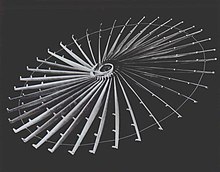This article needs additional citations for verification. (December 2023) |


A kinetic energy weapon (also known as kinetic weapon, kinetic energy warhead, kinetic warhead, kinetic projectile, kinetic kill vehicle) is a projectile weapon based solely on a projectile's kinetic energy to inflict damage to a target, instead of using any explosive, incendiary/thermal, chemical or radiological payload. All kinetic weapons work by attaining a high flight speed — generally supersonic or even up to hypervelocity — and collide with their targets, converting their kinetic energy and relative impulse into destructive shock waves, heat and cavitation. In kinetic weapons with unpowered flight, the muzzle velocity or launch velocity often determines the effective range and potential damage of the kinetic projectile.
Kinetic weapons are the oldest and most common ranged weapons used in human history, with the projectiles varying from blunt projectiles such as rocks and round shots, pointed missiles such as arrows, bolts, darts, and javelins, to modern tapered high-velocity impactors such as bullets, flechettes, and penetrators. Typical kinetic weapons accelerate their projectiles mechanically (by muscle power, mechanical advantage devices, elastic energy or pneumatics) or chemically (by propellant combustion, as with firearms), but newer technologies are enabling the development of potential weapons using electromagnetically launched projectiles, such as railguns, coilguns and mass drivers. There are also concept weapons that are accelerated by gravity, as in the case of kinetic bombardment weapons designed for space warfare.
The term hit-to-kill, or kinetic kill, is also used in the military aerospace field to describe kinetic energy weapons accelerated by a rocket engine. It has been used primarily in the anti-ballistic missile (ABM) and anti-satellite weapon (ASAT) fields, but some modern anti-aircraft missiles are also kinetic kill vehicles. Hit-to-kill systems are part of the wider class of kinetic projectiles, a class that has widespread use in the anti-tank field.